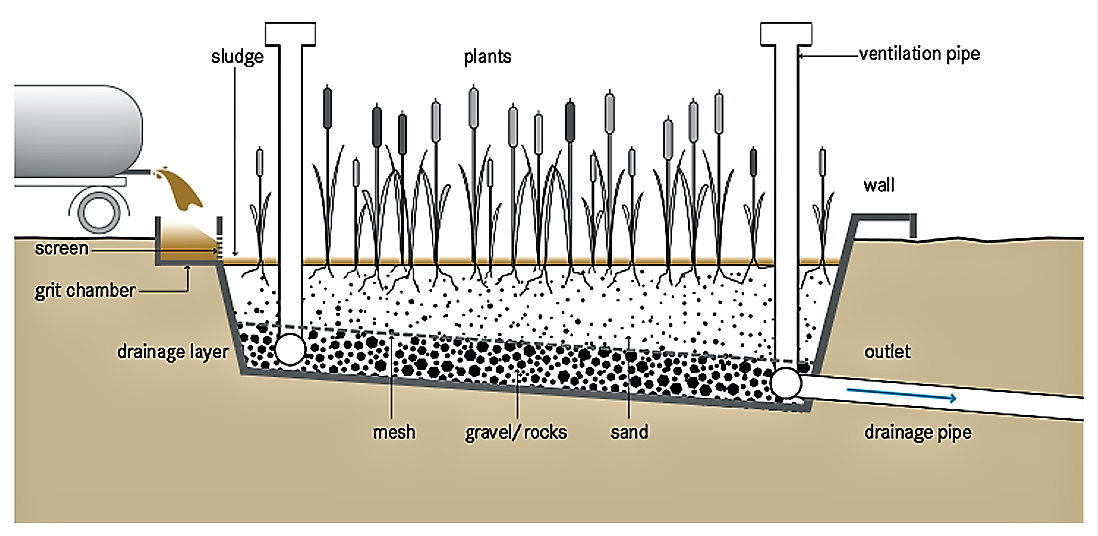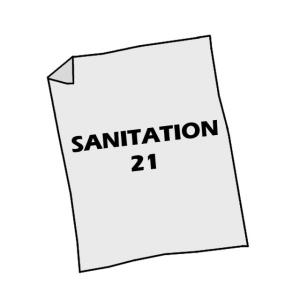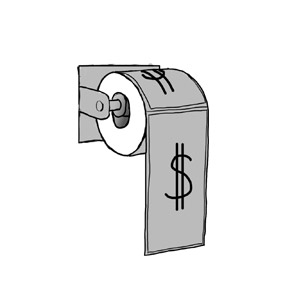Executive Summary
A planted drying bed is similar to an Unplanted Drying Bed, but has the added benefit of transpiration and enhanced sludge treatment due to the plants. The key improvement of the planted bed over the unplanted bed is that the filters do not need to be desludged after each feeding/drying cycle. Fresh sludge can be directly applied onto the previous layer; the plants and their root systems maintain the porosity of the filter.
Introduction
This technology has the benefit of dewatering and stabilising the sludge. Also, the roots of the plants create pathways through the thickening sludge that allow water to easily escape.
The appearance of the bed is similar to a Vertical Flow Constructed Wetland. The beds are filled with sand and gravel to support the vegetation. Instead of effluent, sludge is applied to the surface and the filtrate flows down through the subsurface where it is collected in drains.

Design Considerations
Ventilation pipes connected to the drainage system contribute to aerobic conditions in the filter. A general design for layering the bed is: (1) 250 mm of coarse gravel (grain diameter of 20 mm); (2) 250 mm of fine gravel (grain diameter of 5 mm); and (3) 100 to 150 mm of sand . Free space (1 m) should be left above the top of the sand layer to account for about 3 to 5 years of accumulation.
Reeds (Phragmites sp.), cattails (Typha sp.) antelope grass (Echinochloa sp.) and papyrus (Cyperus papyrus)are suitable plants, depending on the climate. Local, non-invasive species can be used if they grow in humid environments, are resistant to salty water and readily reproduce after cutting.
Sludge should be applied in layers between 75 to 100 mm thick and reapplied every 3 to 7 days, depending on the sludge characteristics, the environment and operating constraints. Sludge application rates of 100 to 250 kg/m2/year have been reported in warm tropical climates. In colder climates, such as northern Europe, rates up to 80 kg/m2/year are typical. Two or more parallel beds can be alternately used to allow for sufficient degradation and pathogen reduction of the top layer of sludge before it is removed.
The leachate that is collected in the drainage pipes must be treated properly, depending on where it is discharged.
Health Aspects/Acceptance
Because of the pleasing aesthetics, there should be few problems with acceptance, especially if located sufficiently away from dense housing. Undisturbed plantations can attract wildlife, including poisonous snakes.
Faecal sludge is hazardous and anyone working with it should wear protective clothing, boots and gloves. The degree of pathogen reduction of the sludge will vary with the climate. Depending on the desired end-use, further storage and drying might be required.
Operation & Maintenance
Trained staff for operation and maintenance is required to ensure proper functioning. The drains must be maintained and the effluent properly collected and disposed of. The plants should have grown sufficiently before applying the sludge. The acclimation phase is crucial and requires much care. The plants should be periodically thinned and/or harvested. After 3 to 5 years the sludge can be removed.
This technology is effective at decreasing the sludge volume (down to 50%) through decomposition and drying, which is especially important when the sludge needs to be transported elsewhere for end-use or disposal.Because of their area requirements, planted drying beds are most appropriate for small to medium communities with populations up to 100,000 people, but they can also be used in bigger cities. If designed to service urban areas, planted drying beds should be at the border of the community, but within economic reach for motorised emptying operators.
Small and Decentralized Wastewater Management Systems
Decentralised wastewater management presents a comprehensive approach to the design of both conventional and innovative systems for the treatment and disposal of wastewater or the reuse of treaded effluent. Smaller treatment plants, which are the concern of most new engineers, are the primary focus of this book.
CRITES, R. TCHOBANOGLOUS, G. (1998): Small and Decentralized Wastewater Management Systems. New York: The McGraw-Hill Companies IncUse of Reed Beds for Faecal Sludge Dewatering
This study project tested reed beds for their ability to treat septage.
HEINSS, U. KOOTAATEP, T. (1998): Use of Reed Beds for Faecal Sludge Dewatering. A Synopsis of Reviewed Literature and Interim Results of Pilot Investigations with Septage Treatment in Bangkok, Thailand. Duebendorf and Bangkok: Swiss Federal Institute of Aquatic Science (Eawag), Department of Water and Sanitation in Developing Countries (Sandec) and Asian Institute of Technology (AIT)Potentials of Sludge Drying Beds Vegetated with Cyperus papyrus L. and Echinochloa pyramidalis (Lam.) Hitchc. & Chase for Faecal Sludge Treatment in Tropical Regions
Treatment of Septage in Constructed Wetlands in Tropical Climate – Lessons Learnt after Seven Years of Operation
This study presents lessons that have been learned from the operation of pilot-scale constructed wetlands (CWs) for septage treatment since 1997. The experiments have been conducted by using three CW units planted with narrow-leave cattails (Typha augustifolia) and operating in a vertical-flow mode.
KOTTATEP, T. SURINKUL, N. POLPRASERT, C. KAMAL, A. S. M. KONE, D. MONTANGERO, A. HEINSS, U. STRAUSS, (2005): Treatment of Septage in Constructed Wetlands in Tropical Climate – Lessons Learnt after Seven Years of Operation. Duebendorf and Pathumthani: Swiss Federal Institute of Aquatic Science (Eawag), Department of Water and Sanitation in Developing Countries (Sandec) and Asian Institute of Technology (AIT) URL [Accessed: 06.06.2019]Faecal Sludge Management
This is the first book to compile the current state of knowledge on faecal sludge management. It addresses the organization of the entire faecal sludge management service chain, from the collection and transport of sludge, to the current state of knowledge of treatment options, and the final end use or disposal of treated sludge. It presents an integrated approach that brings together technology, management, and planning, based on Sandec’s 20 years of experience in the field. It also discusses important factors to consider when evaluating and upscaling new treatment technology options. The book is designed for undergraduate and graduate students, engineers, and practitioners in the field who have some basic knowledge of environmental and/or wastewater engineering.
STRANDE, L. ; RONTELTAP, M. ; BRDJANOVIC, D. (2014): Faecal Sludge Management. Systems Approach for Implementation and Operation. London: IWA Publishing URL [Accessed: 16.07.2014]










